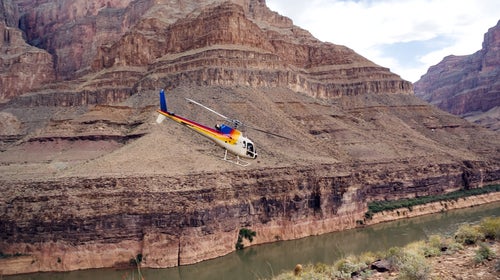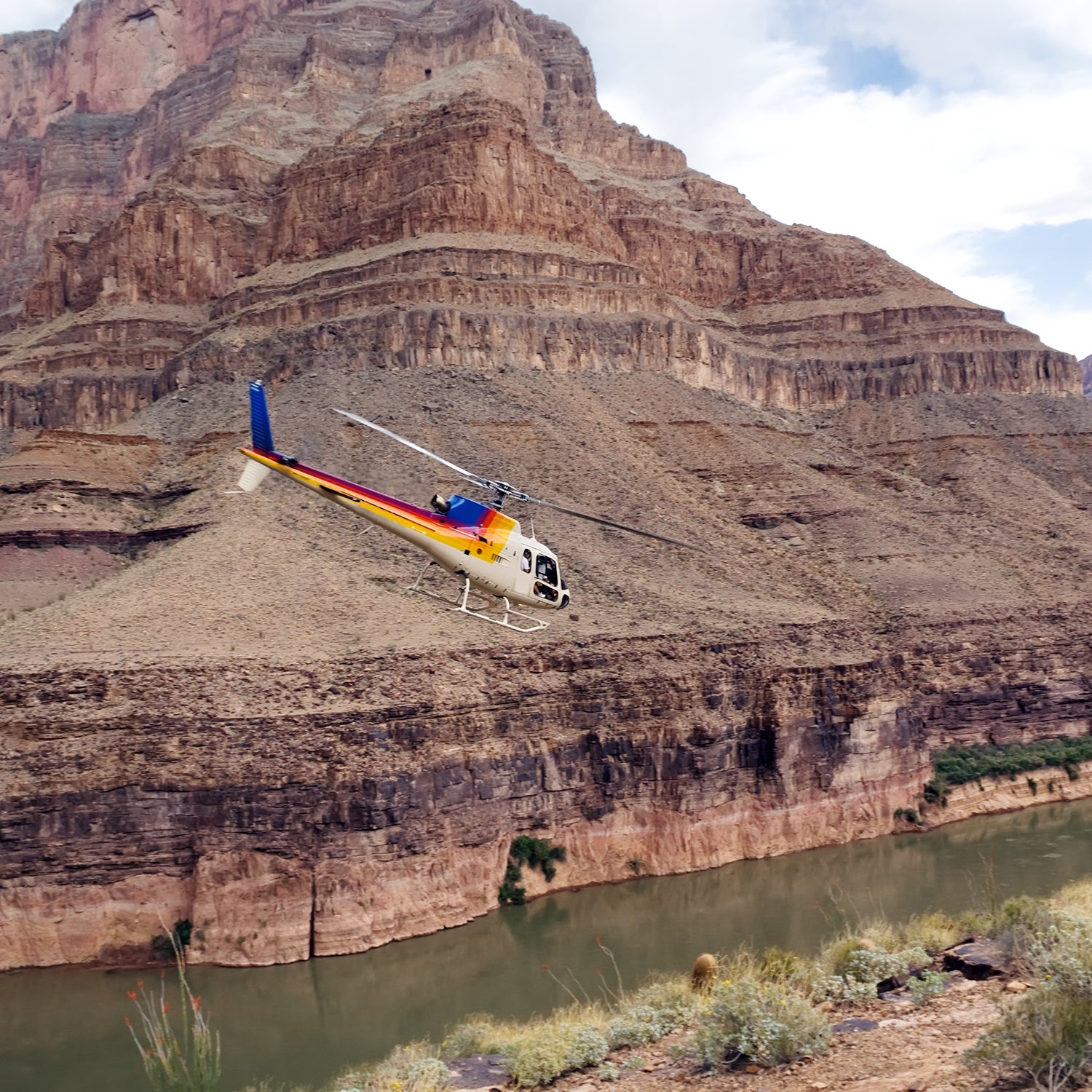In August 2018, about 250 fed-up Hawaiians filed into a Department of Transportation meeting in Hilo to rail against a steady stream of helicopters passing over their homes—as many as 80 a day—en route to Hawaii Volcanoes National Park. One commenter, standing at the microphone, said, “It’s getting to the point where you think I could hit that thing with a .357.”
Over the past decade, Hawaii’s helicopter tour business has , buzzing the state with tens of thousands of flights annually. Residents are irritated that there is no beach, trail, or surf spot where they can escape the noisy machines. That’s without mentioning the danger—in April 2019 a Novictor Helicopters aircraft was 13 minutes into a scenic tour when it plummeted onto the street of an Oahu residential neighborhood, killing all three aboard. No residents were hurt, and only a parked rental car was damaged, but the crash heightened locals’ anger with the industry.
Hawaiians aren’t alone. Frustrations with the intrusive machines have long simmered in some of the nation’s most scenic spots. Groups have mobilized against helicopter tours in Grand Canyon and Glacier National Parks for decades, while trail users are fighting the overflights in places like Jackson Hole, Wyoming; Sedona, Arizona;�����Ի� even Los Angeles, where tours hover above the Hollywood sign in Griffith Park.
The problem, opponents say, is that no matter how vigorous the opposition, the Federal Aviation Administration ultimately has authority over the tours and has shown no interest in limiting the industry.��
While skies are currently quiet over most of the country due to the pandemic, the presence of helicopter tours is still on the minds of many communities, including residents of Jackson Hole. In April, the Jackson Hole Airport Board from Wind River Air to operate on their tarmac, despite six hours of public testimony against the tours from local residents over Zoom—more than 350 comments.
As it happens, all five members of the Jackson Hole airport board oppose the scenic helicopter tours. The problem, , is that a condition of the federal funding that makes up the majority of their budget states that they aren’t allowed to discriminate against any aviation business that the FAA approves. While, in 2018, the FAA authorized Wind River Air to perform air tours with 25 nautical miles of the Jackson Hole Airport outside of the park boundary, the Jackson Hole airport board later to the FAA on the grounds of safety. The board’s reasoning was that Wind River Air planned to use a Robinson R44 helicopter, the same type that crashed into the Oahu neighborhood earlier in 2019�����Ի� that, according to by the Los Angeles Times, was involved in 42 fatal crashes between 2006 and 2016, more than any other civilian helicopter model.��(The owner of Wind River Air, Tony Chambers, did not comment to ���ϳԹ��� about his company’s use of the R44 but has previously discounted concerns over the model’s safety, according to the nonprofit news source WyoFile’s .)��
In to the FAA, the airport board wrote that the proposed air tour routes “would overfly mountainous terrain between 8,000 and 9,200 feet. At these altitudes the R44’s normally aspirated engine would develop only 76.2 and 73.5% of the horsepower it would produce at sea level…This would appear to give the aircraft very little, if any, margin of safety…”
The FAA , and Wind River Air began flying tourists over the Tetons in June.��
Helicopter tour opponents are used to the FAA ignoring them. Some have been fighting the agency since 1986 with little to show for it. Mary T. McClelland leads , a coalition of 33 organizations pushing for more regulation of the helicopter tour industry over Glacier National Park.
According to the , which helps the FAA and the National Park Service implement air tour management plans, there were more than 650 helicopter overflights of Glacier National Park in 2016, almost all during the busy summer season. Any number is too many over a national park that is almost entirely designated wilderness, McClelland says. Solitude and tranquility are among the official qualifications for wilderness designation, she says, and “it takes just one helicopter to break that tranquility.” She describes hiking in some of Glacier’s wildest, most remote locations only to have the serenity shattered by a parade of helicopters packed with gawking tourists. “It feels particularly defeating to lose the immersive experience when you’ve made a real physical effort to achieve it,” she says.��
Park officials, McClelland notes, also don’t want it this way. Glacier’s 1999 General Management Plan called for a total ban of helicopter air tours. “The NPS believes that visitors to Glacier National Park’s backcountry should have the opportunity to experience Glacier’s peacefulness and solitude without disruption by scenic air tours,” .
But with the FAA running the show, opponents have little recourse to effect change.��
There is a law on the books that could provide relief for national park visitors. The (ATMP) requires the FAA and NPS to create a plan for each park with more than 50 overflights a year�����Ի� allows them to demand quieter technology, limit flights, or ban them altogether. However, despite more than 47,000 air tours over 78 different national parks annually, , the only units with plans signed off on by the FAA are Florida’s Big Cypress National Preserve and Biscayne National Park, Utah’s Rainbow Bridge National Monument, and Glen Canyon National Recreation Area, which spans Arizona and Utah. In Glacier, officials from the FAA and NPS convened in 2003 to work on the plan for the park, but it was never completed. McClelland and Quiet! Glacier believe that the FAA has dragged its feet because it didn’t want one of its first management plans to set the precedent of banning helicopter tours outright. (A spokesperson for the FAA declined to comment on the ATMP and Glacier National Park.)
In 2019, Public Employees for Environmental Responsibility (PEER) and Hawaii Island Coalition Malama Pono (HICOP) sued the FAA and NPS to force them to implement the law. Their suit named seven NPS sites: Bryce Canyon, Glacier, Great Smoky Mountains, Haleakala, Hawaii Volcanoes, Lake Mead National Recreation Area, and Muir Woods National Monument (which no longer qualifies because it has fewer than 50 overflights per year). “If there is no credible threat of a mandatory limit, tour operators have zero incentive to voluntarily impose one,” says PEER general counsel Paula Dinerstein.��
The holdup isn’t with the Park Service, says Jon Jarvis, NPS director during the Obama administration. “We treated natural quiet the same way we did clean air and water—as a resource to be protected and maintained,” he says. “The FAA is a frustrating agency to work with.” (The NPS did not respond to a question about its current working relationship with the FAA.)
The ATMP law, Jarvis explains, directed the Park Service to determine how helicopter tours affected park resources, while the FAA was to ensure safety. As the lead agency, the FAA had the final say, even in environmental matters. The problem, he notes, is that one of the FAA’s core missions is to promote aviation, which is at odds with curtailing it.
“Everyone who works at the FAA is a pilot,” adds Dick Hingston, a Sierra Club representative on the National Parks Overflights Advisory Group. Even when mandated by law, he says, the FAA frequently drags its feet on limiting the multimillion-dollar air tour business. In one prominent example, legislators and environmental groups have struggled with the FAA and NPS for nearly two decades to establish overflight rules in the Grand Canyon.��
On May 1, the U.S. Court of Appeals for Washington, DC, , going even further than the places named in the suit in ordering the FAA and NPS to create air tour plans for all 23 remaining national parks where there are more than 50 air tours a year, as the law stipulated 20 years ago. It gave them 120 days to come up with a timetable for compliance and a total of two years to complete the plans.
In 2017, when lava flows at Hawaii Volcanoes National Park , the park endured nearly 17,000 air tours. NPS surveys have found that helicopter noise is audible in 98 percent of the park’s wilderness areas, disturbing wildlife and park visitors. Add that to the nearly 5,000 heli-tours a year over Maui’s Haleakala National Park, tens of thousands of flights over the Napali Coast, and over Oahu’s Pearl Harbor, Waikiki Beach, and North Shore surf spots, it’s hard for state residents to find refuge from the helicopters overhead.��
For Hawaii’s Congressman Ed Case, the final straw was the April 2019 accident when the Robinson R44 helicopter crashed into the Oahu neighborhood. Five months later, Case introduced the . “There’s a groundswell of opposition to these tours now,” he says. “The FAA has shown no interest in regulating this industry.” Case has taken to keeping an eye on the Flightradar24 app on his phone, which tracks air traffic in real time. When we spoke in January, he noted, “Right now, for example, there are six helicopters over Waimea Canyon State Park on Kauai�����Ի� three over Hawaii Volcanoes.”
“Safety is the FAA’s top priority,” a spokesperson said. “The agency has a comprehensive oversight program aimed at ensuring all operators that we regulate adhere to the highest possible levels of safety.”
The Safe and Quiet Skies Act would prohibit tours over national parks, wildlife refuges, wilderness areas, military installations, and cemeteries. The last two are poignant for Case’s district, which includes the Pearl Harbor Memorial. He describes a January ceremony at the facility that was blotted out by the noise from tour helicopters. “Pearl Harbor is a place of great sanctity for victims and their families,” he says.
Case’s proposal would also prohibit tour helicopters from flying lower than 1,500 feet, stop the potentially unsafe practice of pilots narrating their tours over headsets, and allow local regulators to ban the tours altogether. While the Safe and Quiet Skies Act has a long way to go—it currently has only four co-sponsors—high-profile helicopter accidents like the one that killed Kobe Bryant in January continue to bring attention to issues surrounding helicopters.
Case applauds the efforts of Jackson Hole residents to push back on a single helicopter tour business, even though they weren’t successful. He notes that the real problems arise when there are multiple companies competing on price and experience. “There are very high incentives to cut corners to save fuel and provide a more thrilling experience, which is very dangerous,” he says. “We are also finding that once these companies get embedded, they are very difficult to dislodge.”
Giving local regulators control over their airspace, as Case’s law intends, would be a great tool for helicopter tour opponents in Jackson Hole, as well as in Sedona, Arizona. The red-rock desert destination has no national park, but 3 million visitors a year normally still crowd into the community to hike, bike, or relax at ritzy spas. Above it all thunders a steady stream of tours, some 10,800 in 2013, according to an airport master plan written in 2014.
That number has grown substantially in the past seven years, says Michael Yarbrough, a retired Sedona lawyer who has taken it upon himself to try to curb the helicopter racket. “I’ve found complaints about helicopter tours in town council minutes as far back as 1995,” he says, but there’s nothing anyone can do about it, because, as in Jackson Hole, the airport accepts federal funding. And though the FAA issued a that stipulates helicopters must fly at least 2,000 feet above the ground to limit disturbance, it’s not enforced. There’s no incentive for air tour companies to fly considerately, Yarbrough says, “because if one company hovers lower over Devil’s Bridge, then the other will too, to get the better review online.”
After six years of effort, however, Yarbrough forged a between heli-tour operators and the community that would create no-fly zones over residential neighborhoods, minimal altitudes over some locations, and a commitment not to hover. The key, he says, has been the involvement of Sedona’s Chamber of Commerce, which unveiled a sustainable tourism plan in May 2019, a section of which . The chamber wields substantial marketing power for the competing tour companies, Yarbrough says, which may be enough to hold the companies to a higher standard.
The May 1 U.S. Court of Appeals decision on the failed implementation of the 2000 Air Tours Management Act stipulated that the NPS and FAA had 120 days to come up with a plan to complete air tour management plans for 23 national parks, and that those plans must all be completed by May 1, 2022. Few quiet-skies activists expected the agencies to comply. There was a 20-year track record of recalcitrance, after all. Yet, on August 31, the agencies .��
PEER’s Dinerstein remains somewhat skeptical, mentioning that just because air tour management plans will be created, that doesn’t mean they will be good plans. “If past is prologue, it will take a lot of work and public pressure to see them to a satisfactory conclusion,” she said in a press release.��
Quiet! Glacier’s McClelland, for one, is ready to help apply that pressure. “One of the National Parks Service’s mandates is to protect the parks, and that includes natural sounds,” she says. It’s important that the public weigh in to make sure that isn’t overlooked, and that it is the role of organizations like hers to help facilitate that process. McClelland points to years of public anti-helicopter activism, like the 2018 hearings in Hilo, Hawaii, or the six hours of testimony over Zoom in Jackson Hole in April, as a positive sign that given a platform to speak, they will.��


